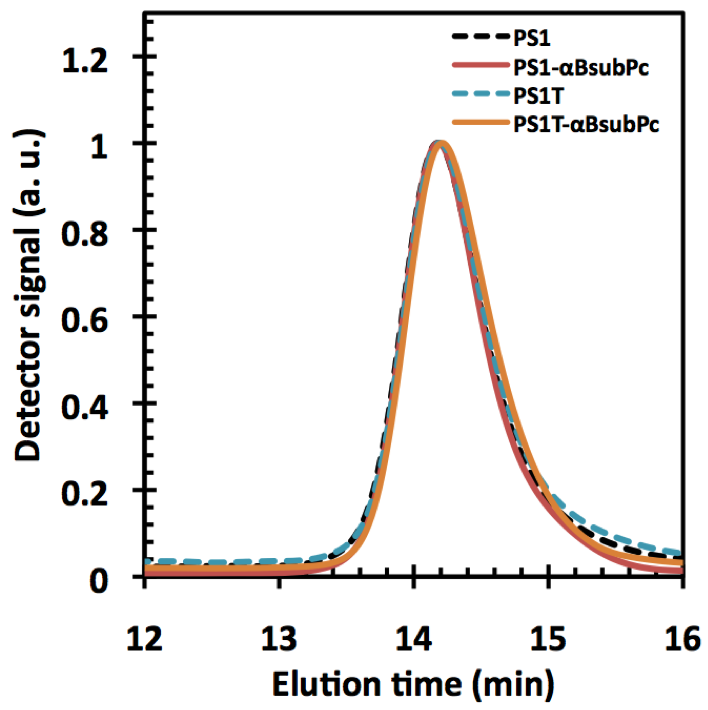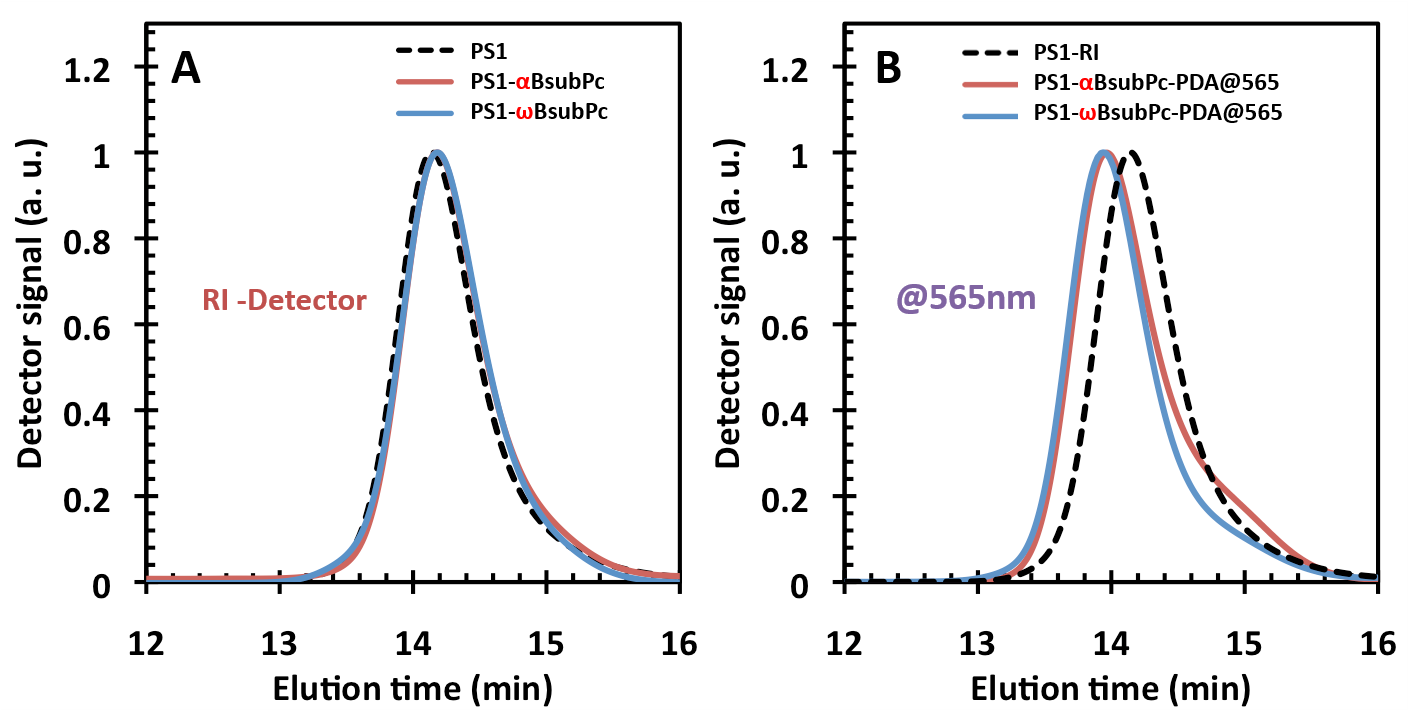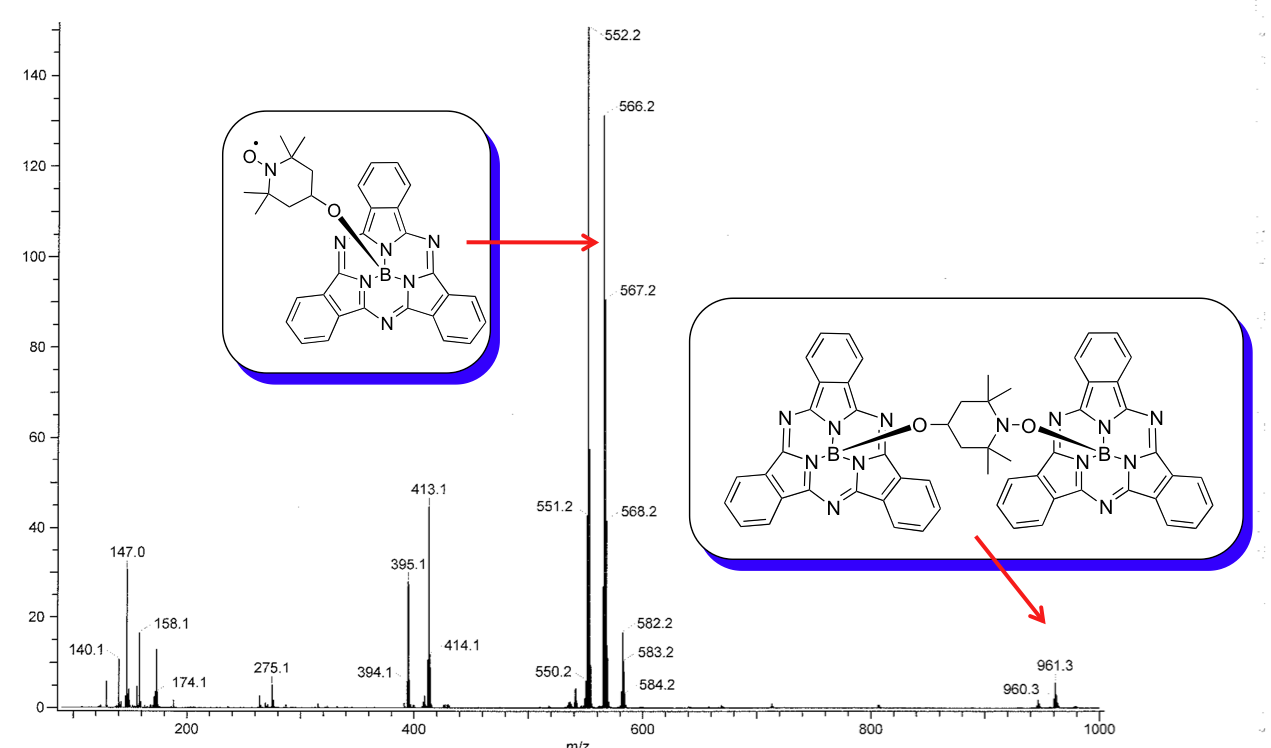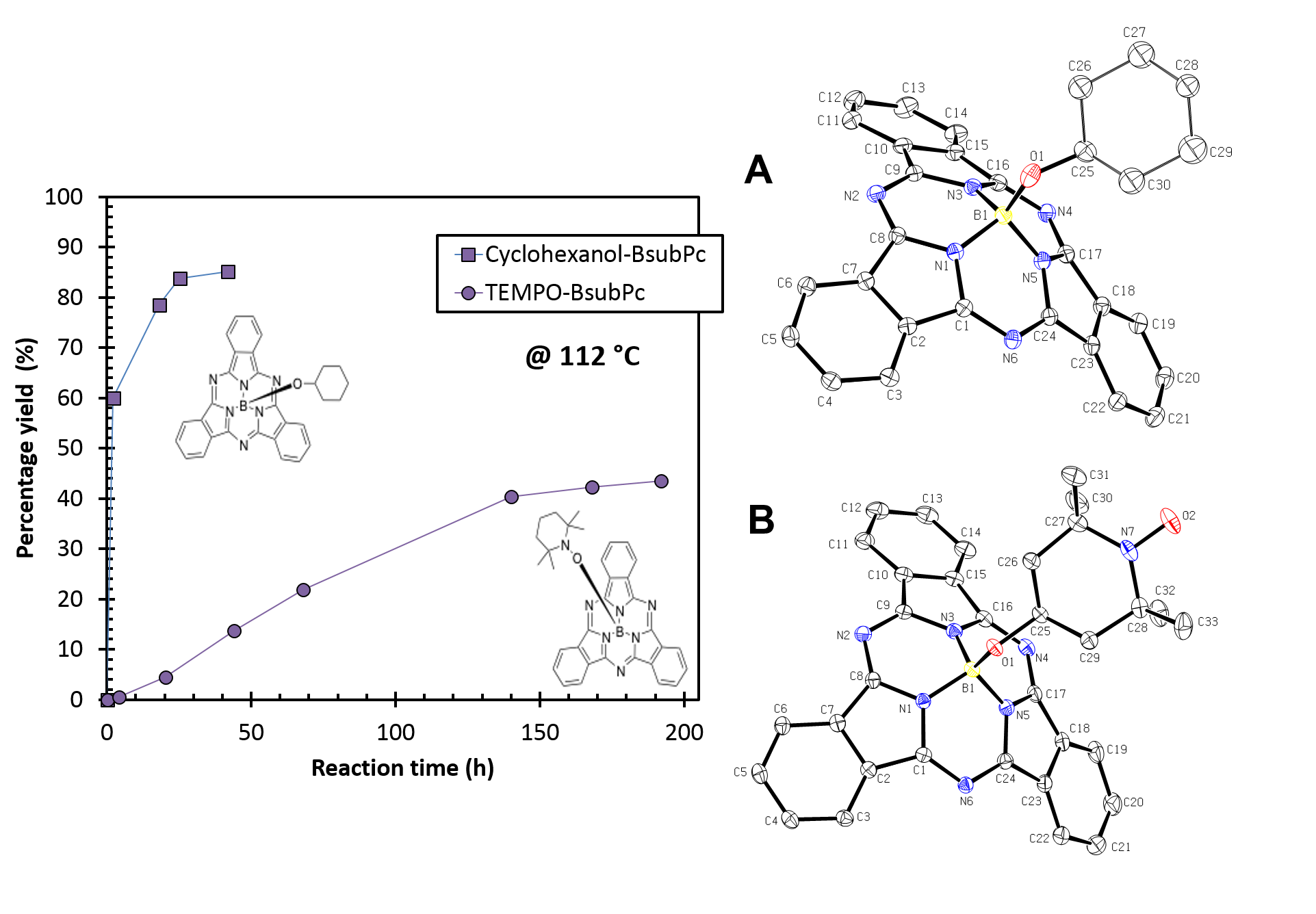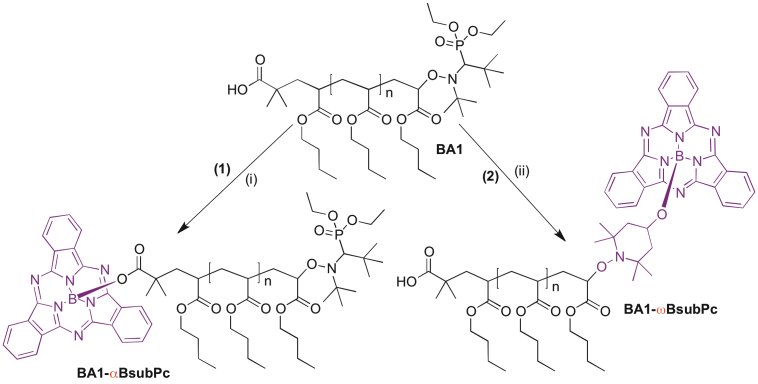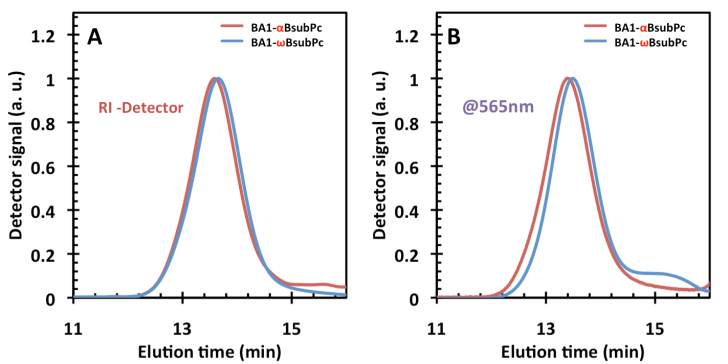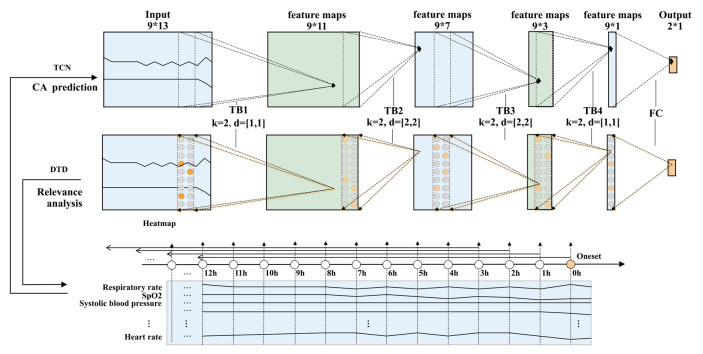1. Introduction
Subphthalocyanine is an aromatic bowl-shaped macrocyclic ligand that exclusively chelates a boron atom (BsubPc, Scheme 1) [1]. BsubPcs are unique members of the broader family of phthalocyanines having only three isoindoline units in their ligand structure compared to four for normal phthalocyanines. BsubPcs have recently received increased interest due to their unique optophysical and electrophysical properties. For example, BsubPcs have found application in organic photovoltaic devices (OPVs) [2,3,4], organic thin film transistors (OTFTs) [5,6] and organic light emitting diodes (OLEDs) [2,7].
Recently, our group synthesized and characterized the first BsubPc containing polymer using a post-polymerization coupling reaction between bromo-BsubPc (Br-BsubPc, 1, Scheme 2) and poly(4-methyl styrene-ran-4-vinylphenol) (poly(4MS-ran-4VP)) copolymers [8]. Subsequently, we have also reported a more facile synthetic route, still utilizing a post-polymerization strategy but involving the reaction of Br-BsubPc with the carboxylic acid groups of a random copolymer of poly(acrylic acid-ran-styrene) (poly(AA-ran-S)) [9]. This more recent method avoids an intermediate post-polymerization deprotection step needed in the first method to produce poly(4MS-ran-4VP) [8,9]. However, we identified that the copolymerization of AA and S resulted in the formation of a small molecule side product that reacted with Br-BsubPc in the subsequent post-polymerization coupling reaction [9]. Prior to incorporating the BsubPc polymers into organic electronic devices it was important to eliminate the formation of this side product. Therefore, we identified that the use of methacrylic acid (MAA), instead of AA, resulted in poly(MAA-ran-S) copolymers with no side product formation [10]. The resulting poly(MAA-ran-S) copolymers were therefore reacted with Br-BsubPc and the product was used as the emissive layer in the first BsubPc polymer-based OLEDs [10]. The resulting OLEDs were characterized by having a very pure orange electroluminescence equivalent to BsubPc small molecules and directly attributable to the BsubPc chromophores [10]. While the reported devices were unoptimized, they left something to be desired: the device brightness and efficiency was moderate and needs to be further improved. It has previously been reported that the polymer end group can have a significant effect on the device performance of both OPVs [11,12] and OLEDs [13]. Therefore, we surmise that incorporation of BsubPcs at the chain ends should or could play a role in the performance of BsubPc containing polymer OLEDs.
In our previous studies, the BsubPc molecule was incorporated pendent to the main chain of a copolymer [8,9,10]. The dispersity of the starting copolymers was kept low in each case by using nitroxide mediated polymerization (NMP), a known form of controlled radical polymerization (CRP) [14,15,16]. Originally, NMP was restricted to the homopolymerization of styrenics when using first-generation stable free radicals (SFRs) such as 2,2,6,6-tetramethylpiperidine-1-oxyl (TEMPO) [14,15,16]. However, the development of second-generation SFRs such as N-tert-butyl-N-[1-diethylphosphono-(2,2-dimethylpropyl)] nitroxide (SG1) [18] and 2,2,5-trimethyl-4-phenyl-3-azahexane-3-nitroxide (TIPNO) [19] have allowed the extension of NMP methodology to the homopolymerization of other monomers including acrylates [20,21], acrylamides [14,22] and methacrylates (when using a small amount of a comonomer [23,24,25]). Through the appropriate selection of initiator and/or SFR, NMP produces polymers with a high level of chain end predictability, which makes targeted chain-end reactions possible [14,15,16]. NMP methods have been previously used to functionalize both the ω- or the α-chain end of a polymer with a variety of functional groups. For example, uracil α-chain end has been functionalized using TEMPO- and SG1-based alkoxyamine unimolecular initiators having been purposefully synthesized to study polymer diffusion [26] and to modify the melt viscosity. [27] The use of commercially available SG1-based alkoxyamine, 2-methyl-2-[N-tert-butyl-N-(1-diethoxyphosphoryl-2,2-dimethylpropyl) aminoxy] propionic acid (BlocBuilder-MA [28,29,30], Scheme 1) can enable the functionalization of the α-chain end through reaction of the carboxylic acid functionality post-polymerization such as the coupling of olefins by performing 1-2 radical additions [31,32,33] or even coupling to protein/peptides and silica particles by coupling a succinimidyl ester moiety followed by subsequent coupling of primary amines [34,35]. While far less common than α-chain end reactions, a few examples of ω-chain end functionalization have been reported for NMP produced polymers. For example, the nitroxide can be readily removed by treating the polymer with a hydrogen donor molecule such as thiol [36] or a non-homopolymerizable monomer such as maleic anhydride [37]. Other examples of ω-chain end functionalization include substituting the native TEMPO nitroxide fragment with another functional 4-substituted TEMPO nitroxide [38,39], or the TIPNO fragment with 4-substituted TIPNO [40] or the SG1 fragment with TEMPO [41].
In this paper we illustrate how the BsubPc chromophore can be selectively introduced to either the ω- or the α- chain end of a polymer produced by NMP utilizing BlocBuilder-MA as the initiating species. This approach will facilitate the functionalization of polymer chain ends in later studies for the synthesis of BsubPc containing polymers for use as the active material in OLEDs and OPVs.
2. Materials and Method
2.1. Materials
4-Hydroxy-2,2,6,6-tetramethylpiperidine 1-oxyl (4-hydroxy-TEMPO, 97%) was obtained from Aldrich and used as received. Bromo boron subphtathalocyanine (Br-BsubPc) was synthesized according to our previously reported method [42]. Common solvents and reagents were obtained from Caledon Laboratories (Caledon, Ontario, Canada) or Sigma-Aldrich Co. (Ontario, Canada) and used as received. BlocBuilder-MA was graciously donated by Prof. Milan Marić (McGill University), who obtained it from Arkema Inc. (USA).
2.2. Synthesis of poly(styrene) (PS) and poly-n-butylacrylate (BA)
In all cases the homopolymers were synthesized under identical experimental setup and similar formulations (Table 1). For example, PS1 was synthesized by combining styrene (5.50 g, 52.9 mmol) and BlocBuilder-MA (0.10 g, 0.26) with a Teflon stir bar in a 50mL three neck round bottom glass flask prior to sealing with rubber septa. The mixture was then bubbled with nitrogen for 20 min and the mixture was heated to 90 °C while maintaining a light nitrogen purge. Once the stirring of the mixture became labored, due to the increase in viscosity, the reaction was allowed to cool to room temperature while maintaining the nitrogen purge (in this example approximately 20 h). Once cooled the mixture was precipitated in methanol, filtered and dried in a vacuum oven at 60 °C overnight. Yield: 1.92 g (35%), Mn = 7.7 kg·mol−1, Mw/Mn = 1.37.
Table 1. Experimental formulation for styrene and butylacrylate homopolymerizations.
| Exp. IDa | [BlocBuilder]0 (mol·L-1) | [S]0 (mol L-1) | Mn Target (kg·mol-1) | Temp. (°C) | tpolym (h) | Mnb (kg·mol-1) | Mw/Mnb |
| PS1 | 0.044 | 8.74 | 20.8 | 90 | 20.0 | 7.7 | 1.37 |
| PS1Tc | – | – | – | 120 | 4.0 | 7.6 | 1.31 |
| PS1-αBsubPc | – | – | – | 125 | 40 | 7.6 | 1.30 |
| PS1T-αBsubPc | – | – | – | 125 | 40 | 7.1 | 1.31 |
| PS1-ωBsubPc | – | – | – | 100 | 0.5 | 8.0 | 1.30 |
| BA1 | 0.056 | 4.83 | 15.9 | 115 | 2.0 | 22.2 | 1.47 |
| BA1-αBsubPc | – | – | – | 125 | 40 | 23.2 | 1.45 |
| BA1-ωBsubPc | – | – | – | 100 | 0.5 | 23.2 | 1.45 |
| a Experimental identification (Exp. ID) for the synthesis of poly(styrene) (PS) are given by PS1-Y and for the synthesis of n-butyl acryalte (BA) is given by BA1-Y, Y representing post polymerization reaction . All polymerizations were done in bulk. Y = αBsubPc is the coupling of (1) by reaction in chlorobenzene and Y = ωBsubPc is the coupling of (2) by reaction in toluene. |
| b Molecular weight characterization was determined by GPC using PS standards. |
| c The PST is PS after being treated to thiophenol in toluene for 4 h for the removal of the SG1 group. |
2.3. Synthesis of BsubPc-TEMPO (2, Scheme 2)
To an oven dried round bottom flask a mixture of Br-BsubPc (1.00 g, 2.11 mmol) and 4-hydroxy-TEMPO (0.54 g, 3.16 mmol) and toluene (≈ 4 mL) were added prior to sealing under nitrogen. The mixture was then heated to reflux for 20 hours. Once cooled to room temperature the organic phase was washed 3 times using 1 M KOH solution and 3 times using neutral water. Once dried, the crude product was purified by column chromatography using 50 vol% ethyl acetate to hexanes as the eluent. Once dried the resulting magenta powder was determined to be BsubPc-TEMPO. Yield = 0.40 g (33%). 1H NMR: 8.8 ppm (6H), 7.9 ppm (6H), 2.8 ppm (1H), 2.0 ppm (4H), 1.4 ppm (12H). 11B NMR: −14.1 ppm (1B) HR-MS (DART) calcd for C33H29BBrN6 ([M]+): m/z 566.2476, found 566.2479.
2.4. BsubPc coupling to poly(styrene) or poly(butyl acrylate) chains
In the case of BsubPc coupling to the α-chain end of PS1, a 1:1.2 molar ratio of the PS1 to Br-BsubPc was dissolved in toluene then heated to 115 °C for 20 h under a nitrogen purge or blanket. Once cooled to room temperature the polymer was precipitated in methanol and collected by filtration. The crude polymer was then dried in a vacuum oven overnight at 60 °C. In the case of BsubPc coupling to the ω-chain end of the PS homopolymers a 1:1.2 molar ratio of the PS homopolymer to BsubPc-TEMPO was dissolved in toluene followed by a 20 min bubbling and purging with nitrogen. The mixture was then heated to 100 °C for 30 min. Once cooled to room temperature the nitrogen purge was removed and the polymer was precipitated in methanol and collected by filtration.
2.5. Characterization
1H NMR spectroscopy that was run on a 400 MHz Varian Mercury spectrometer at 23 °C in deuterated chloroform (CDCl3, with Me4Si) obtained from Cambridge Isotopes Laboratory, Inc.. Molecular weight characterization and determination of BsubPc coupling was performed by gel permeation chromatography (GPC), using narrow molecular weight distribution poly(styrene) (PS) standards and two Waters Styragel 5 μm, HR 4E 7.8 × 300 mm column in series. The GPC was equipped with a Waters 2695 separation module, a Waters 2998 photodiode array (PDA detector) and a Waters 2414 refractive index detector (RI Detector) and HPLC grade THF was used as the mobile phase at a flow rate of 1.2 mL·min−1. Single crystal X-ray diffraction data was collected on a Bruker Kappa APEX-DUO diffractometer using a Copper ImuS (microsource) tube with multi-layer optics and were measured using a combination of f scans and w scans. The data was then processed using APEX2 and SAINT and the absorption correction was carried out using SADABS [43]. The structure was then solved and refined using SHELXTL [44] for full-matrix least-squares refinement that was based on F2.
3. Results and Discussion
We began by synthesizing poly(styrene) homopolymers (PS1) using BlocBuilder-MA as the initiating species (Scheme 1). The formulation and molecular characterization of PS1 can be found in Table 1 and the GPC chromatograms for PS1 (RI-detection) can be found in Figure 1.
3.1. BsubPc functionalization of polymer on the α-chain end
Br-BsubPc contains a highly reactive Br-B bond which in the presence of a carboxylic acid group results in the facile coupling of the BsubPc chromophore to the carboxylic acid group [9]. When using BlocBuilder-MA as an NMP initiating species, the PS chains have a carboxylic acid group present on the α-chain end (Scheme 1). Thus, Br-BsubPc was reacted with the PS homopolymers under identical conditions to that previously reported for the reaction of Br-BsubPc with poly(AA-ran-S) [9] to produced polymer PS1-αBsubPc (αBsubPc notation indicates the BsubPc chromophore is resident on the α-chain end). Using a GPC with a photodiode array (PDA) detector (set to 565 nm, the ~λmax of BsubPc chromophore) in-line with a RI detector it is obvious that the Br-BsubPc indeed couples to the PS chains (Figure 2,more discussion below). Using RI detection the resulting BsubPc coupled PS experienced very little change in molecular weight characteristics (Figure 1 and Figure 2A), indicating the BsubPc chromophore has little or no impact on the hydrodynamic volume of the polymer. To confirm that this reaction is in fact due to the coupling of Br-BsubPc and the carboxylic acid group at the α-chain end and not also at the ω-chain end (by a potential radical coupling reaction with an active radical present at the process temperature) a sample of PS1 polymer was first cleaved of its SG1 fragment by treatment with thiophenol [36]. This intermediate polymer (PS1T) was reacted with Br-BsubPc to produce polymer PS1T-αBsubPc (Scheme 1). GPC chromatograms of PS1, PS1 coupled with Br-BsubPc directly (PS1-αBsubPc), PS1 that has had the SG1 groups removed (PS1T) and the resulting PS1 sample after coupling to Br-BsubPc (PS1T- αBsubPc) are illustrated in Figure 1and are all identical. This confirms that there is indeed no reaction between Br-BsubPc and the ω-chain end (nitroxide fragment or active radical) and that the reaction with Br-BsubPc is chemically selective with the carboxylate functionality at the α-chain end.
3.2. Development of the synthesis of BsubPc-TEMPO
To place the BsubPc chromophore at the ω-chain end we took the strategy of removing or replacing the SFR fragment [38,39,40,41]. It is well known that the equilibrium constant of TEMPO is significantly lower than that of SG1 and that substitution of the SG1 fragment on a polymer (polymer that is reversibly terminated with SG1) for a TEMPO group is possible at relatively low temperatures (≈ 70 to 110 °C) [38,39,40,41]. Therefore, a BsubPc derivative-containing TEMPO (BsubPc-TEMPO, 2, Scheme 2) was synthesized so as to be used to substitute the SG1 fragment while incorporating a BsubPc group in one step.
The synthesis of BsubPc-TEMPO was achieved by reaction of Br-BsubPc with 4-hydroxy-2,2,6,6-tetramethylpiperidin-1-oxyl (Scheme 2). The molecular structure and purity of BsubPc-TEMPO was confirmed using normal spectroscopic methods (For example Mass spectrometry, Figure 3). Its identity was further confirmed from a single crystal grown by slow diffusion of hexanes into a solution of BsubPc-TEMPO in dichloromethane. The resulting crystal was diffracted using X-ray crystallography (CCDC deposition number 953761). The thermal ellipsoidal plot with 50% probability is shown in Figure 4a. Detailed crystallographic information can be found in Table S1-6. However we should note that the synthesis was complicated by the previously unknown reaction of the nitroxide with the labile Br-B bond of Br-BsubPc. During the reaction of Br-BsubPc with TEMPO it was observed that a large molecular weight side product was obtained if the mixture was allowed to react for excessive time periods. This high molecular weight product was determined to have a mass consistent, with a dimeric BsubPc molecule (Figure 3).
In attempts to find an appropriate synthetic operating window for BsubPc-TEMPO, we decided to explore the synthesis of both reactive sites. Therefore we performed two independent syntheses, under the same reaction conditions (chlorobenzene, 112 °C), and measured the relative yield with time. TEMPO (not 4-hydroxy-TEMPO) and cyclohexanol were both independently reacted with Br-BsubPc in a 5:1 molar excess (Figure 4) to compare the relative kinetics. The kinetics was tracked by comparing the relative area under the curve of the HPLC chromatogram obtained using a mixture of 80/20 volume ratio of acetonitrile and DMF. We observed that the reaction of cyclohexanol (which we assumed has a similar reactivity to the hydroxyl group on 4-hydrox-TEMPO) was much faster than the reaction of Br-BsubPc with TEMPO (Figure 4). Therefore the reaction of 4-hydrox-TEMPO with Br-BsubPc was time controlled to a couple hours to prevent/significantly reduce the formation of the dimeric side product. We did investigate the possibility that the BsubPc coupled with TEMPO could be used as a unimolecular initiator for styrene polymerization but at 125 °C no polymerization was noted and the compound degraded. A single crystal of the cyclohexanol BsubPc derivative was also grown by evaporation from DCM and diffracted (CCD deposition # 968575). The 50% probability thermal ellipsoid plot can be found in Figure 4b. Detailed crystallographic information can be found in Table S7-11 in the supporting information.
3.3. BsubPc functionalization of polymer on the ω-chain end with BsubPc-TEMPO
BsubPc-TEMPO was allowed to react at 90 °C for 30 min with PS1 (terminated with SG1) to produce PS1-ωBsubPc. A temperature of 90 °C was sufficient to facilitate the replacement of the SG1 fragment for the BsubPc-TEMPO fragment as indicated by the GPC chromatogram obtained from the PDA detector set at 565 nm (Figure 2B). We determined that if the reaction was allowed to proceed for longer than 30 min the concentration of irreversible terminated chains increased resulting in a decrease in BsubPc-TEMPO terminated chains. For PS1 very little change in their apparent mass due to the addition of BsubPc-TEMPO was noted based on RI detection (Figure 2A). The reader should also note that our GPC is set up with a PDA detector first and in line with a RI detector. The length of tubing between the two is approximately 60 cm which accounts for the differences in retention time seen between chromatograms extracted from the PDA and RI detectors (Figure 2B).
3.4. Application of BsubPc end group labeling to poly(n-butyl acrylate)
To further explore the application of this technique and the ability of BsubPc reagents to couple to the chain ends, n-butyl acrylate was homopolymerized under similar conditions using BlocBuilder-MA (BA1) and again both chain ends were coupled with BsubPc (Scheme 3). Similar to PS1, the GPC traces taken using an RI detector and using a PDA detector set at 565nm for both BA1 reacted with Br-BsubPc (BA1-αBsubPc) and that reacted with BsubPc-TEMPO (BA1-ωBsubPc) can be found in Figure 5A and B, respectively. These results illustrate that this end-group BsubPc coupling strategy is effective for both PS and PBA polymers (and most likely other polymers) synthesized by NMP using BlocBuilder-MA.
3.5. Potential implications of BsubPc dye labeling α-chain and ω-chain end
BsubPc have been reported to have extremely high extinction coefficient (65 000-75 000 L mol−1 cm−1) [45] thus their detection even within polymers of very high molecular weight is or would be easy. These features would make BsubPc containing polymers ideal candidates for dyes-labeled polymers [46]. When considering Figure 2B and 5B it is apparent that the GPC traces corresponding to the polymers functionalized with BsubPc on the α-chain end (initiating side) and those with BsubPc on the ω-chain end (propagation side) are not identical and that the PDA traces differ from each other and the corresponding RI traces of the unreacted parent homopolymers. We can offer several hypotheses or explanations. Firstly is that the RI detector response is based on mass concentration while the PDA detector response is based on molar concentration basis. This difference means that when a BsubPc chromophore is coupled to a small chain, the response is more significant as observed by the PDA detector, then when coupled to a larger chain. This amplification in detector response for the smaller polymer chains could potentially be utilized to shed insight on the nature of the chain ends and ultimately it could be used to comment on the degree of irreversible termination which has occurred in the initial polymer synthesis. For example, Scott et al. have previously demonstrated that they could quantified the chain end livingness once they reversibly end-capped a series of polymers with a fluorescent-TEMPO SFR followed by the comparison of the fluorescence spectra and the RI trace obtained when running a GPC [47]. However in our case the same polymer sample is coupled with a BsubPc chromophore selectively on either end and therefore could potentially give insight on the nature of both the propagating and the initiating end of the polymer chains. For example, when comparing the scaled GPC chromatograms for PS1 reacted with Br-BsubPc (PS1-αBsubPc, Figure 2) to that reacted with BsubPc-TEMPO (PS1-ωBsubPc, Scheme 1) and considering the difference in the chromatograms, it can be seen that there is a portion of low molecular weight PS chains that are not reversibly terminated with the nitroxide fragment at the ω-end as they did not incorporate BsubPc-TEMPO into their chemical structure but they do react with Br-BsubPc at the α-end (Figure 2B). The difference is seen at longer elution time, appearing as an increased tail or shoulder on the chromatogram. This difference is not observed or not observed to the same extent when using the RI-Detector (Figure 2A and 1C). Unlike styrenics, acrylates have little tendency to autoinitiate and should result in the majority of chains initiated by BlocBuilder-MA [14]. Figure 5A shows very little difference between the chains when characterized using RI-detector while Figure 5B illustrates a slight amplification in detector response for the smaller polymer chains that were detected using the PDA. However, unlike the PS1, BA1 has a larger portion of smaller chains (higher elution time) that are coupled with BsubPc-TEMPO respective to those coupled with Br-BsubPc. A possible explanation is that a portion of chains which are initially initiated by BlocBuilder-MA but undergo chain transfer to monomer results in propagating chains which do not have the alkoxyamine initiating fragment [48]. Acrylates are prone to chain transfer reactions [49] and this technique allows us to potentially visualize this effect. As a check the same sample (BA1-αBsubPc) was run three times using the GPC under different dilutions and the same observations were made (see supporting information for spectrum).
The difference in GPC traces acquired by the RI detector and the PDA detector (Figure 2 and 5) can give an illustration of the amount of irreversible termination imparted to the system when using BlocBuilder. It is, however, crucial to note that styrene has a tendency to auto-initiate [50,51] and therefore in this simple system there may be a portion of chains which are not initiated by BlocBuilder-MA but do contain the nitroxide fragment at their ω-ends, making this analysis that we present here non quantitative. Regardless, our experiments show that by derivatizing a polymer at each end using the same chromophore (such as BsubPc), which has a very high molar extinction coefficient, an amplification in detector response is observed for the smaller chains, which can give insight on the degree of irreversible termination of the sample.
4. Conclusion
This study illustrates a novel and selective method for functionalizing each end of a polymer chain produced by NMP with a BsubPc chromophore. By synthesizing polymers using BlocBuilder-MA as the initiating species and using two separate and chemically selective BsubPc reagents, Br-BsubPc and TEMPO-BsubPc we can selectively couple a BsubPc chromophore to either the initiating chain end, α-chain end, or the propagating chain end, w-chain end, respectively. Two generic model polymers were used to illustrate that this technique is versatile, poly(styrene) and poly(n-butyl acrylate). In both cases the coupling was observed using a GPC equipped with a PDA detector in line with an RI detector. In this paper we illustrate how the BsubPc chromophore can be selectively introduced to either the ω- or the α- chain end of a polymer produced by NMP utilizing BlocBuilder-MA as the initiating species. This method will facilitate the functionalization of polymer chain ends resulting in BsubPc polymers with BsubPc chromophores both pendent to the main chain [10] and at both chain ends. Future studies will utilize this technique to investigate the effect of BsubPc end
-group coupling on OLED device performance.
Acknowledgments
We would like to thank Natural Science and Engineering Research Council (NSERC) of Canada Discovery Grant program for financial support. BL would like to thank the government of Canada for the Banting Post Doctoral Fellowship. We thank Alan Lough (University of Toronto) for the single crystal x-ray diffractions. We also thank Prof. Milan Maric from McGill University (Quebec, Canada) for graciously donating BlocBuilder-MA (originally obtained from Arkema).
Supplementary
Electronic SupplementaryInformation (ESI) available: X-ray crystalography data; proof of reproducibility of GPC chromatograms.









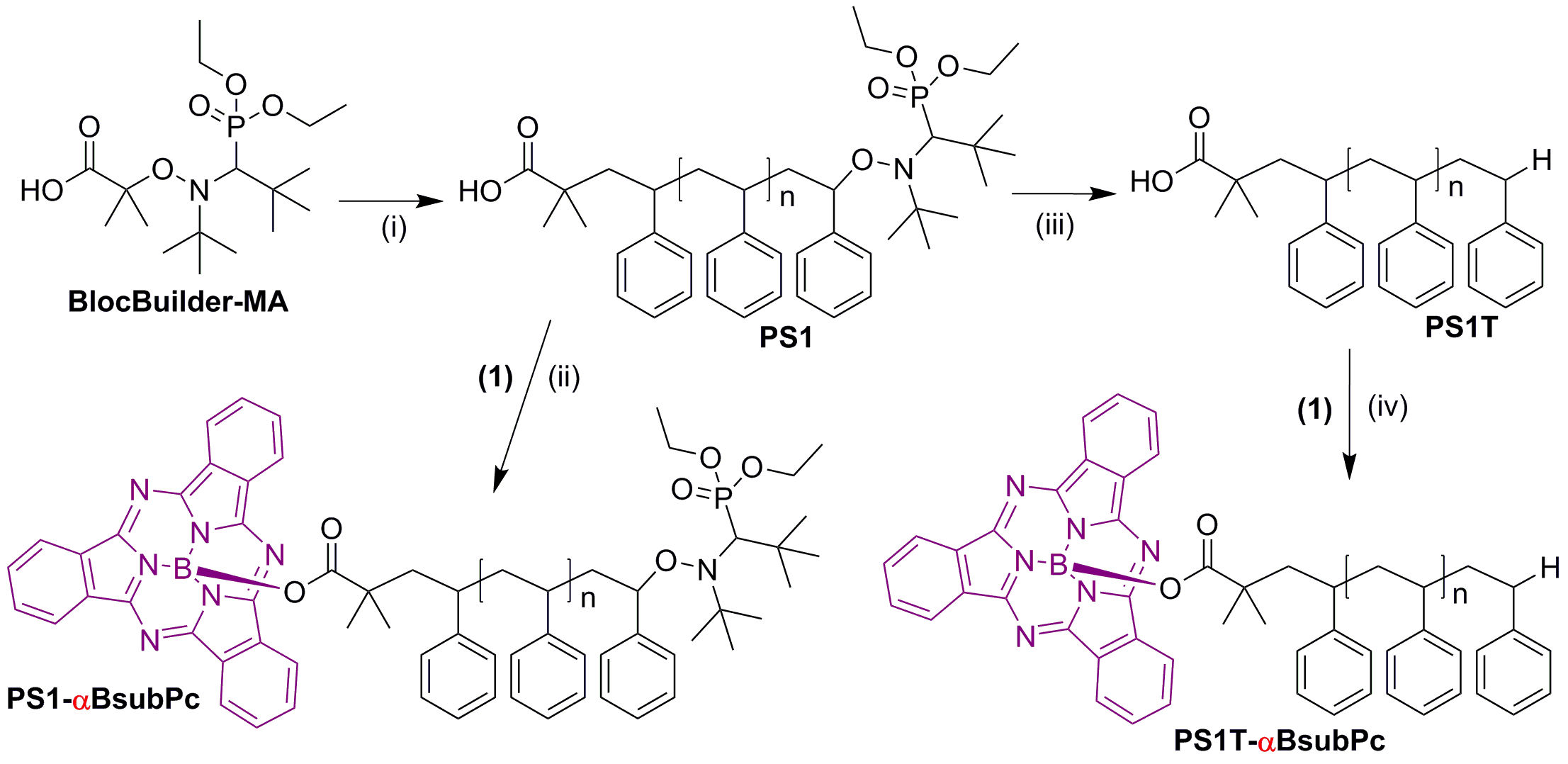
 DownLoad:
DownLoad: 
